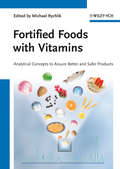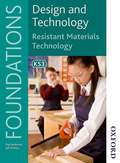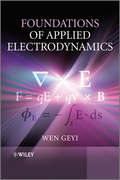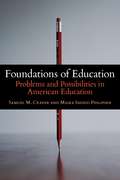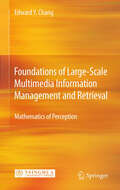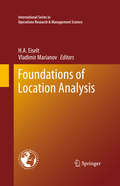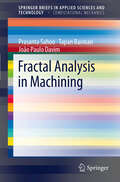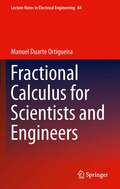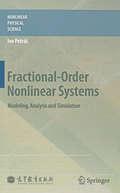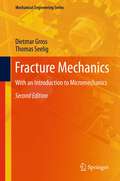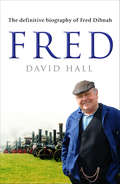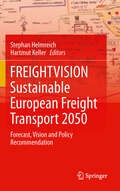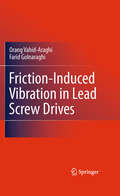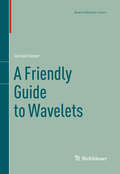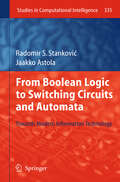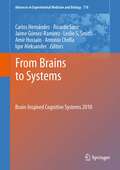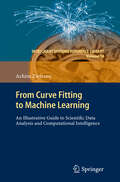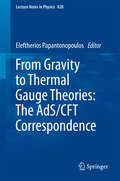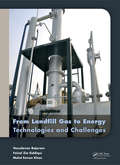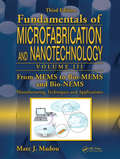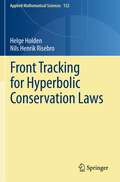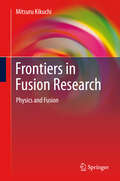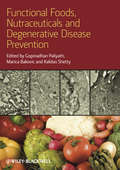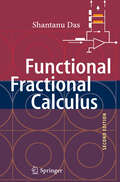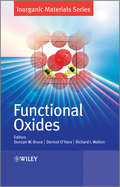- Table View
- List View
Fortified Foods with Vitamins: Analytical Concepts to Assure Better and Safer Products
by Michael RychlikUnique in its review of modern analytical approaches to vitamin fortification, this book emphasizes fast, sensitive, and accurate methods, along with assays enabling the detection of various isomers and multiple vitamins. The expert contributors describe the concepts as well as analytical and assay methods to study fortification, along with applications to create better and safer foods. Taking into considerations regulatory matters, they include data on sampling and extraction methods, and discuss the various pros and cons of each. As a result, readers are able to determine, which type of analytical method is best suited for added vitamins. A practical guide for food chemists and technologists, as well as analytical laboratories and biochemists.
Foundations KS3: Resistant Materials Technology (PDF)
by Paul Anderson Jeff Draisey'Design and Technology Foundations' student books are matched to the KS3 assessment criteria and programme of study, with engaging content and activities to help develop the design skills and knowledge required at Key Stage 3 and beyond.
Foundations of Applied Electrodynamics
by Wen GeyiFoundations of Applied Electrodynamics takes a fresh look at the essential concepts and methods of electrodynamics as a whole, uniting the most relevant contemporary topics under a common mathematical framework. It contains clear explanations of high-level concepts as well as the mutual relationships between the essential ideas of electromagnetic theory. Starting with the fundamentals of electrodynamics, it methodically covers a wide spectrum of research and applications that stem from electromagnetic phenomena, before concluding with more advanced topics such as quantum mechanics. Includes new advances and methodologies in applied electrodynamics, and provides the whole picture of the theory of electrodynamics in most active areas of engineering applications Systematically deals with eigenvalue problems, integral equation formulations and transient phenomena in various areas of applied electrodynamics Introduces the complete theory of spherical vector wave functions, and presents the upper bounds of the product of gain and bandwidth for an arbitrary antenna Presents the field approach to multiple antenna system, which provides a theoretical tool for the prediction of channel models of MIMO, and is also the basis of wireless power transmission system One of the first books on electromagnetics that contains the general theory of relativity, which is needed in the design of mobile systems such as global positioning system (GPS) By summarising both engineering and theoretical electromagnetism in one volume, this book is an essential reference for practicing engineers, as well as a guide for those who wish to advance their analytical techniques for studying applied electrodynamics.
Foundations of Education: Problems and Possibilities in American Education
by Samuel M. Craver Maike Ingrid PhilipsenFoundations of Education is organized around the major problems facing contemporary American education. It offers a thorough, scholarly treatment of these problems from historical, philosophical, and sociological perspectives, bringing together relevant findings from those disciplines to analyze and illuminate a wide range of issues. Each chapter focuses on a core topic (including race, gender, equal opportunities, school governance) to give students a solid overview, providing intellectually sound material that offers real depth and challenges students to think creatively.Packed with exercises, discussion questions, international case studies for comparative purposes and supported by a fully up-to-date companion website, this is a text that responds to current developments, changes, and trends in teacher education. Foundations of Education will prepare a new generation of educators for a globalized and technology-driven society that needs to be aware of its best educational traditions, its current problems and its future possibilities.
Foundations of Large-Scale Multimedia Information Management and Retrieval: Mathematics of Perception
by Edward Y. Chang"Foundations of Large-Scale Multimedia Information Management and Retrieval: Mathematics of Perception" covers knowledge representation and semantic analysis of multimedia data and scalability in signal extraction, data mining, and indexing. The book is divided into two parts: Part I - Knowledge Representation and Semantic Analysis focuses on the key components of mathematics of perception as it applies to data management and retrieval. These include feature selection/reduction, knowledge representation, semantic analysis, distance function formulation for measuring similarity, and multimodal fusion. Part II - Scalability Issues presents indexing and distributed methods for scaling up these components for high-dimensional data and Web-scale datasets. The book presents some real-world applications and remarks on future research and development directions. The book is designed for researchers, graduate students, and practitioners in the fields of Computer Vision, Machine Learning, Large-scale Data Mining, Database, and Multimedia Information Retrieval.Dr. Edward Y. Chang was a professor at the Department of Electrical & Computer Engineering, University of California at Santa Barbara, before he joined Google as a research director in 2006. Dr. Chang received his M.S. degree in Computer Science and Ph.D degree in Electrical Engineering, both from Stanford University.
Foundations of Location Analysis (International Series in Operations Research & Management Science #155)
by H. A. Eiselt Vladimir MarianovLocation analysis has matured from an area of theoretical inquiry that was designed to explain observed phenomena to a vibrant field which can be and has been used to locate items as diverse as landfills, fast food outlets, gas stations, as well as politicians and products in issue and feature spaces. Modern location science is dealt with by a diverse group of researchers and practitioners in geography, economics, operations research, industrial engineering, and computer science. Given the tremendous advances location science has seen from its humble beginnings, it is time to look back. The contributions in this volume were written by eminent experts in the field, each surveying the original contributions that created the field, and then providing an up-to-date review of the latest contributions. Specific areas that are covered in this volume include: • The three main fields of inquiry: minisum and minimax problems and covering models • Nonstandard location models, including those with competitive components, models that locate undesirable facilities, models with probabilistic features, and problems that allow interactions between facilities • Descriptions and detailed examinations of exact techniques including the famed Weiszfeld method, and heuristic methods ranging from Lagrangean techniques to Greedy algorithms • A look at the spheres of influence that the facilities generate and that attract customers to them, a topic crucial in planning retail facilities • The theory of central places, which, other than in mathematical games, where location science was born
Fractal Analysis in Machining (SpringerBriefs in Applied Sciences and Technology)
by Prasanta Sahoo Tapan Barman J. Paulo DavimThe concept of fractals is often considered to describe surface roughness. Fractals retain all the structural information and are characterized by a single descriptor, the fractal dimension, D. Fractal dimension is an intrinsic property of the surface and independent of the filter processing of measuring instrument as well as the sampling length scale. This book cover fractal analysis of surface roughness in different machining processes such as Computer Numeric Control (CNC) end milling, CNC turning, electrical discharge machining and cylindrical grinding. The content here presented adds a significant contribution to the existing literature, with interest to both industrial and academic public.
Fractional Calculus for Scientists and Engineers (Lecture Notes in Electrical Engineering #84)
by Manuel Duarte OrtigueiraThis book gives a practical overview of Fractional Calculus as it relates to Signal Processing
Fractional-Order Nonlinear Systems: Modeling, Analysis and Simulation (Nonlinear Physical Science)
by Ivo Petráš"Fractional-Order Nonlinear Systems: Modeling, Analysis and Simulation" presents a study of fractional-order chaotic systems accompanied by Matlab programs for simulating their state space trajectories, which are shown in the illustrations in the book. Description of the chaotic systems is clearly presented and their analysis and numerical solution are done in an easy-to-follow manner. Simulink models for the selected fractional-order systems are also presented. The readers will understand the fundamentals of the fractional calculus, how real dynamical systems can be described using fractional derivatives and fractional differential equations, how such equations can be solved, and how to simulate and explore chaotic systems of fractional order.The book addresses to mathematicians, physicists, engineers, and other scientists interested in chaos phenomena or in fractional-order systems. It can be used in courses on dynamical systems, control theory, and applied mathematics at graduate or postgraduate level. Ivo Petráš is an Associate Professor of automatic control and the Director of the Institute of Control and Informatization of Production Processes, Faculty of BERG, Technical University of Košice, Slovak Republic. His main research interests include control systems, industrial automation, and applied mathematics.
Fracture Mechanics: With an Introduction to Micromechanics (Mechanical Engineering Series)
by Dietmar Gross Thomas Seelig- self-contained and well illustrated- complete and comprehensive derivation of mechanical/mathematical results with enphasis on issues of practical importance- combines classical subjects of fracture mechanics with modern topics such as microheterogeneous materials, piezoelectric materials, thin films, damage- mechanically and mathematically clear and complete derivations of results
Fred: The Definitive Biography Of Fred Dibnah
by David HallFred Dibnah's World celebrates the life and work of Britain's best known steeplejack and national treasure, Fred Dibnhah. Before his death in 2004, Fred presented many popular series, including Magnificent Monuments, The Age of Steam and Made in Britain, all of which attracted viewers in their millions.Fred is the companion to the 12-part BBC2 series celebrating the life of this great man, which combines highlights from some of Dibnah's classic programmes with previously unseen footage. The book can of course go much further than the series, including an extraordinarily account of Fred's childhood which evokes a lost England and our great industrial heritage. Fred's passion for the glories of the Victorian age and his fascination with the landscape he grew up in, plus his admiration for the craftsmen and labourers who made it all possible, captivate us on every page. Fred is the personification of everything that made England great in the first place. And this is a glorious tribute to a man whom millions came to love.
FREIGHTVISION - Sustainable European Freight Transport 2050: Forecast, Vision and Policy Recommendation
by Stephan Helmreich and Hartmut KellerThis book has been written on the basis of the research done between 2008 and 2010 as part of the European Commission funded FREIGHTVISION project. The “FREIGHTVISION - Freight Transport 2050 Foresight” project was funded by the Directorate General MOVE to design a long term vision for European freight transport in 2050 and to identify actions and research to progress appropriate freight transport measures in Europe. The project was carried out as a foresight process encompassing four conferences in which the project team identified and developed with the aid of more than 100 experts an action plan for securing long term freight transport in Europe. The book provides insights into the freight transport visions and Backcasts identified for 2035 and 2050, issues which need to be addressed and measures which were assessed to be part of future paths to assure an economical, environmental, and social freight transport system.
Friction-Induced Vibration in Lead Screw Drives
by Orang Vahid-Araghi Farid GolnaraghiFriction-Induced Vibration in Lead Screw Drives covers the dynamics of lead screw drives with an emphasis on the role of friction. Friction-induced vibration in lead screws can be the cause of unacceptably high levels of audible noise as well as loss of operation accuracy and shortened life. Although lead screw drives have a long history and their mechanical design and manufacturing aspects are very well understood, the role of friction in their dynamical behavior has not been comprehensively treated. The book draws on the vast body of work on the subject of dynamical systems with friction (such as disk brake systems) and offers said treatment, along with: · Unique coverage of modeling of multi-DOF lead screw systems with friction· Detailed analysis of negative damping, mode coupling, and kinematic constraint instability mechanisms in lead screws drives· A practical parameter identification approach for the velocity dependent coefficient of friction in lead screw drives Friction-Induced Vibration in Lead Screw Drives serves as the definitive text on the friction-induced vibration of lead screws, and includes a practical case study where the developed methods are used to study the excessive noise problem of a lead screw drive system and to put forward design modifications that eliminate the friction-induced vibrations.
A Friendly Guide to Wavelets (Modern Birkhäuser Classics)
by Gerald KaiserThis volume is designed as a textbook for an introductory course on wavelet analysis and time-frequency analysis aimed at graduate students or advanced undergraduates in science and engineering. It can also be used as a self-study or reference book by practicing researchers in signal analysis and related areas. Since the expected audience is not presumed to have a high level of mathematical background, much of the needed analytical machinery is developed from the beginning. The only prerequisites for the first eight chapters are matrix theory, Fourier series, and Fourier integral transforms. Each of these chapters ends with a set of straightforward exercises designed to drive home the concepts just covered, and the many graphics should further facilitate absorption.
From Boolean Logic to Switching Circuits and Automata: Towards Modern Information Technology (Studies in Computational Intelligence #335)
by Radomir S. Stankovic Jaakko AstolaLogic networks and automata are facets of digital systems. The change of the design of logic networks from skills and art into a scientific discipline was possible by the development of the underlying mathematical theory called the Switching Theory. The fundamentals of this theory come from the attempts towards an algebraic description of laws of thoughts presented in the works by George J. Boole and the works on logic by Augustus De Morgan. As often the case in engineering, when the importance of a problem and the need for solving it reach certain limits, the solutions are searched by many scholars in different parts of the word, simultaneously or at about the same time, however, quite independently and often unaware of the work by other scholars. The formulation and rise of Switching Theory is such an example. This book presents a brief account of the developments of Switching Theory and highlights some less known facts in the history of it. The readers will find the book a fresh look into the development of the field revealing how difficult it has been to arrive at many of the concepts that we now consider obvious . Researchers in the history or philosophy of computing will find this book a valuable source of information that complements the standard presentations of the topic.
From Brains to Systems: Brain-Inspired Cognitive Systems 2010 (Advances in Experimental Medicine and Biology #718)
by Carlos Hernández, Ricardo Sanz, Jaime Gómez-Ramirez, Leslie S. Smith, Amir Hussain, Antonio Chella and Igor AleksanderBrain Inspired Cognitive Systems - BICS 2010 aims to bring together leading scientists and engineers who use analytic and synthetic methods both to understand the astonishing processing properties of biological systems and specifically of the brain, and to exploit such knowledge to advance engineering methods to build artificial systems with higher levels of cognitive competence. BICS is a meeting point of brain scientists and cognitive systems engineers where cross-domain ideas are fostered in the hope of getting emerging insights on the nature, operation and extractable capabilities of brains. This multiple approach is necessary because the progressively more accurate data about the brain is producing a growing need of a quantitative understanding and an associated capacity to manipulate this data and translate it into engineering applications rooted in sound theories. BICS 2010 is intended for both researchers that aim to build brain inspired systems with higher cognitive competences, and for life scientists who use and develop mathematical and engineering approaches for a better understanding of complex biological systems like the brain. Four major interlaced focal symposia are planned for this conference and these are organized into patterns that encourage cross-fertilization across the symposia topics. This emphasizes the role of BICS as a major meeting point for researchers and practitioners in the areas of biological and artificial cognitive systems. Debates across disciplines will enrich researchers with complementary perspectives from diverse scientific fields. BICS 2010 will take place July 14-16, 2010, in Madrid, Spain.
From Curve Fitting to Machine Learning: An Illustrative Guide to Scientific Data Analysis and Computational Intelligence (Intelligent Systems Reference Library #18)
by Achim ZielesnyThe analysis of experimental data is at heart of science from its beginnings. But it was the advent of digital computers that allowed the execution of highly non-linear and increasingly complex data analysis procedures - methods that were completely unfeasible before. Non-linear curve fitting, clustering and machine learning belong to these modern techniques which are a further step towards computational intelligence.The goal of this book is to provide an interactive and illustrative guide to these topics. It concentrates on the road from two dimensional curve fitting to multidimensional clustering and machine learning with neural networks or support vector machines. Along the way topics like mathematical optimization or evolutionary algorithms are touched. All concepts and ideas are outlined in a clear cut manner with graphically depicted plausibility arguments and a little elementary mathematics. The major topics are extensively outlined with exploratory examples and applications. The primary goal is to be as illustrative as possible without hiding problems and pitfalls but to address them. The character of an illustrative cookbook is complemented with specific sections that address more fundamental questions like the relation between machine learning and human intelligence. These sections may be skipped without affecting the main road but they will open up possibly interesting insights beyond the mere data massage.All topics are completely demonstrated with the aid of the commercial computing platform Mathematica and the Computational Intelligence Packages (CIP), a high-level function library developed with Mathematica's programming language on top of Mathematica's algorithms. CIP is open-source so the detailed code of every method is freely accessible. All examples and applications shown throughout the book may be used and customized by the reader without any restrictions. The target readerships are students of (computer) science and engineering as well as scientific practitioners in industry and academia who deserve an illustrative introduction to these topics. Readers with programming skills may easily port and customize the provided code.
From Gravity to Thermal Gauge Theories: The AdS/CFT Correspondence (Lecture Notes in Physics #828)
by Eleftherios PapantonopoulosThe AdS/CFT correspondence is a powerful tool in studying strongly coupled phenomena in gauge field theories, using results from a weakly coupled gravity background studied in the realm of string theory. AdS/CFT was first successfully applied to the study of phenomena such as the quark-gluon plasma produced in heavy ions collisions. Soon it was realized that its applicability can be extended, in a more phenomenological approach, to condensed matter systems and to systems described by fluid dynamics. The set of tutorial reviews in this volume is intended as an introduction to and survey of the principle of the AdS/CFT correspondence in its field/string theoretic formulation, its applicability to holographic QCD and to heavy ions collisions, and to give a first account of processes in fluid dynamics and condensed matter physics, which can be studied with the use of this principle. Written by leading researchers in the field and cast into the form of a high-level but approachable multi-author textbook, this volume will be of benefit to all postgraduate students, and newcomers from neighboring disciplines wishing to find a comprehensive guide for their future research.
From Landfill Gas to Energy: Technologies and Challenges
by Vasudevan Rajaram Faisal Zia Siddiqui M. Emran KhanConverting old landfills to energy producing sites, while capturing emitted greenhouse gases, has faced numerous technical, financial and social challenges and developments lately. Also, the re-mining of landfills to recover useful land in dense urban areas and proper landfill closure has been a subject of discussion and investigation. Designed as
From MEMS to Bio-MEMS and Bio-NEMS: Manufacturing Techniques and Applications
by Marc J. MadouFrom MEMS to Bio-MEMS and Bio-NEMS: Manufacturing Techniques and Applications details manufacturing techniques applicable to bionanotechnology. After reviewing MEMS techniques, materials, and modeling, the author covers nanofabrication, genetically engineered proteins, artificial cells, nanochemistry, and self-assembly. He also discusses scaling la
Front Tracking for Hyperbolic Conservation Laws (Applied Mathematical Sciences #152)
by Helge Holden Nils Henrik RisebroHyperbolic conservation laws are central in the theory of nonlinear partial differential equations and in science and technology. The reader is given a self-contained presentation using front tracking, which is also a numerical method. The multidimensional scalar case and the case of systems on the line are treated in detail. A chapter on finite differences is included.From the reviews:"It is already one of the few best digests on this topic. The present book is an excellent compromise between theory and practice. Students will appreciate the lively and accurate style." D. Serre, MathSciNet "I have read the book with great pleasure, and I can recommend it to experts as well as students. It can also be used for reliable and very exciting basis for a one-semester graduate course." S. Noelle, Book review, German Math. Soc."Making it an ideal first book for the theory of nonlinear partial differential equations...an excellent reference for a graduate course on nonlinear conservation laws." M. Laforest, Comp. Phys. Comm.
Frontiers in Fusion Research: Physics and Fusion
by Mitsuru KikuchiFrontiers in Fusion Research provides a systematic overview of the latest physical principles of fusion and plasma confinement. It is primarily devoted to the principle of magnetic plasma confinement, that has been systematized through 50 years of fusion research. Frontiers in Fusion Research begins with an introduction to the study of plasma, discussing the astronomical birth of hydrogen energy and the beginnings of human attempts to harness the Sun’s energy for use on Earth. It moves on to chapters that cover a variety of topics such as: • charged particle motion, • plasma kinetic theory, • wave dynamics, • force equilibrium, and • plasma turbulence. The final part of the book describes the characteristics of fusion as a source of energy and examines the current status of this particular field of research. Anyone with a grasp of basic quantum and analytical mechanics, especially physicists and researchers from a range of different backgrounds, may find Frontiers in Fusion Research an interesting and informative guide to the physics of magnetic confinement.
Functional Foods, Nutraceuticals, and Degenerative Disease Prevention
by Gopinadhan Paliyath Marica Bakovic Kalidas ShettyFunctional Foods, Nutraceuticals and Degenerative Disease Prevention is a compilation of different segments of functional foods and nutraceuticals focusing on their mechanism of action in the human body leading to disease prevention. Numerous chapters deal with different functional foods in terms of their efficacy, highlighting the mechanism of action of their ingredients. The book focuses on the biochemistry and molecular biology of the disease prevention process rather than simply compiling the benefits of functional foods and nutraceuticals. Aimed primarily at an audience comprised of researchers, industry professionals, food scientists, medical professionals and graduate level students, Functional Foods, Nutraceuticals and Degenerative Disease Prevention offers a mechanism-based interpretation for the effect of nutraceuticals within the human body. Ultimately, the discussion of the biological effects of a variety of functional foods will provide a wholesome approach to the maintenance of health through judicious choice of functional foods.
Functional Fractional Calculus
by Shantanu DasWhen a new extraordinary and outstanding theory is stated, it has to face criticism and skeptism, because it is beyond the usual concept. The fractional calculus though not new, was not discussed or developed for a long time, particularly for lack of its application to real life problems. It is extraordinary because it does not deal with ‘ordinary’ differential calculus. It is outstanding because it can now be applied to situations where existing theories fail to give satisfactory results. In this book not only mathematical abstractions are discussed in a lucid manner, with physical mathematical and geometrical explanations, but also several practical applications are given particularly for system identification, description and then efficient controls. The normal physical laws like, transport theory, electrodynamics, equation of motions, elasticity, viscosity, and several others of are based on ‘ordinary’ calculus. In this book these physical laws are generalized in fractional calculus contexts; taking, heterogeneity effect in transport background, the space having traps or islands, irregular distribution of charges, non-ideal spring with mass connected to a pointless-mass ball, material behaving with viscous as well as elastic properties, system relaxation with and without memory, physics of random delay in computer network; and several others; mapping the reality of nature closely. The concept of fractional and complex order differentiation and integration are elaborated mathematically, physically and geometrically with examples. The practical utility of local fractional differentiation for enhancing the character of singularity at phase transition or characterizing the irregularity measure of response function is deliberated. Practical results of viscoelastic experiments, fractional order controls experiments, design of fractional controller and practical circuit synthesis for fractional order elements are elaborated in this book. The book also maps theory of classical integer order differential equations to fractional calculus contexts, and deals in details with conflicting and demanding initialization issues, required in classical techniques. The book presents a modern approach to solve the ‘solvable’ system of fractional and other differential equations, linear, non-linear; without perturbation or transformations, but by applying physical principle of action-and-opposite-reaction, giving ‘approximately exact’ series solutions.Historically, Sir Isaac Newton and Gottfried Wihelm Leibniz independently discovered calculus in the middle of the 17th century. In recognition to this remarkable discovery, J.von Neumann remarked, “…the calculus was the first achievement of modern mathematics and it is difficult to overestimate its importance. I think it defines more equivocally than anything else the inception of modern mathematical analysis which is logical development, still constitute the greatest technical advance in exact thinking.”This XXI century has thus started to ‘think-exactly’ for advancement in science & technology by growing application of fractional calculus, and this century has started speaking the language which nature understands the best.
Functional Oxides (Inorganic Materials Series #12)
by Duncan W. Bruce Dermot O’Hare Richard I. WaltonFunctional oxides have a wide variety of applications in the electronic industry. The discovery of new metal oxides with interesting and useful properties continues to drive much research in chemistry, physics, and materials science. In Functional Oxides five topical areas have been selected to illustrate the importance of metal oxides in modern materials chemistry: Noncentrosymmetric Inorganic Oxide Materials Geometrically Frustrated Magnetic Materials Lithium Ion Conduction in Oxides Thermoelectric Oxides Transition Metal Oxides - Magnetoresistance and Half-Metallicity The contents highlight structural chemistry, magnetic and electronic properties, ionic conduction and other emerging areas of importance, such as thermoelectricity and spintronics. Functional Oxides covers these complex concepts in a clear and accessible manner providing an excellent introduction to this broad subject area.
